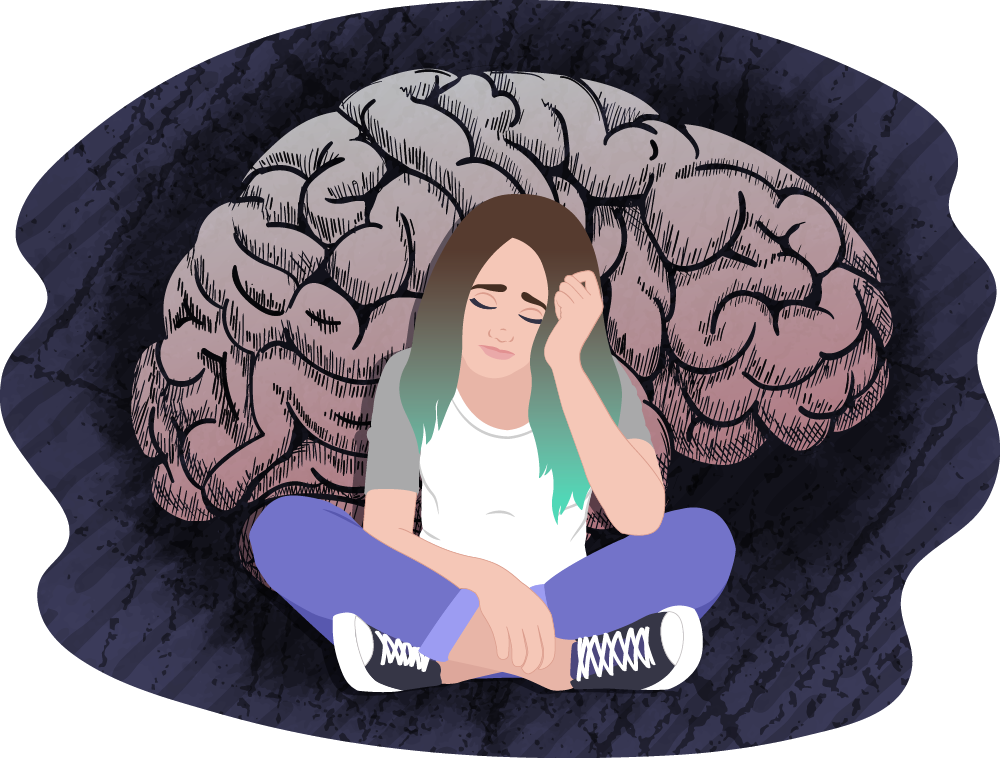Assignment Help on Treatment Plan for Depression
Diagnosis:
To make a definite diagnosis of the depressive illness, it is important to know the signs and symptoms of the disease that are evident in various studies (“HelpGuide.org,” 2019). Mental disorders show a plethora of symptoms, and the signs and symptoms may vary in various patients. Many patients suffering from depressive illness may not show all the symptoms that are usually seen in depressive disorders. Following are the symptoms that are frequently found in patients of depressive illness (“HelpGuide.org,” 2019):
- Off mood
- Amotivation
- Losing interest
- Hopelessness in behavior
- Fatigue
- Anxiety
- Irritability
- Emotional changes
- Diminished appetite
- Delineated thoughts (the patient may experience suicidal thoughts)
- Physical manifestations: Headache

The clinical diagnostic criteria of the depressive disorder are explained by the American Psychiatric Association (Depression, 2020). In order to make the clinical diagnosis of depression symptoms, the patient must report at least five symptoms present simultaneously over a period of at least two weeks, and one of the major symptoms should be depressed mood or low interest/feeling of pleasure:
- Depressed mood or irritability in children or young teenagers
- Anhedonia- diminished interest or pleasure feelings
- Loss of appetite resulting in weight loss
- Suicidal thoughts, thoughts about death or attempt to exterminate one’s life
- Insomnia or hypersomnia
- Psychological retardation
- Fatigue or lethargy
- Feeling of worthlessness
- Lack of ability to focus or loss of concentration
Not only the depressive disorder manifests differently in various individuals but also overlies with various other illnesses. Depressive disorders are linked with a generalized anxiety disorder (GAD), panic disorder, social phobia and anxiety disorders etc. (Fulghum, 2008). Anxiety may be seen in patients of depressive illnesses. Still, the depressed mood is the major symptom is a depressive disorder, but anxiety is associated with tachycardia, shakiness and sweating etc.
Depression links with social phobia such that the depressed patients feel repulsion when they come to the society. These patients are found to be abandoning social gathering. Depressed patients avoid social interaction (Fulghum, 2008).
The depressive illness causes patients to panic more frequently than normal patients. Depression is linked with an irritability that leads to panic (Fulghum, 2008).
Depression has links with the society. The social support is important to prevent and cure depression. Certain studies show that the people that are closely linked to other members of society are less vulnerable to depression (“Gulf Bend MHMR Center,” 2020). Physical and mental reassurance in events of crisis and panic is valuable in the prevention of depression. Cultural setups are related to mental disorders. Ethnomedicine is the specialized field that deals with the impact and implications of cultural factors on the mental and psychological health and well-being of a person. Ethnomedicine specialists suggest that the combined or nuclear family systems, individuality, modes of earning, social role and responsibilities are important factors that shape the mental pathways and determine the vulnerability of an individual to the mental illnesses (“Gulf Bend MHMR Center,” 2020).

Causes:
Biological Theory of the Depressive Disorder:
One is the genetic theory of depression that proposes the genes that are the main culprit causing depressive illness (Goldstein, Potter, Ciraulo, & Shader, 2010). Mutated genes cause a change in mental pathways resulting in depression. Such genes, when inherited into next-generation result in depression. So it is found to be running in families in such cases. Another theory is the neurotransmitter theory, in which the dysregulation in the levels of various neurotransmitters. In cases where the levels of neurotransmitters are normal, but the degradation of receptors for those neurotransmitters or upregulation of the receptors leads to an abnormal amount of stimulation or diminished stimulation leading to depression. Serotonin (5-HT) and Dopamine (DA) are mainly involved in depressive disorder. Low levels of neurotransmitters cause depression. This results in synaptic insufficiency. Neuropsychological theory reflects the relation of altered brain wave activity affect mood and causes depression. Neuroendocrine disorders are also a cause of depression. Long-term overactivity of the hypothalamus-pituitary-adrenal axis and related abnormalities of neurohormonal pathways cause depressive illness (Goldstein, Potter, Ciraulo, & Shader, 2010). Study of brain areas shows that the prefrontal cortex, striatum, thalamus, hypothalamus, amygdala and hippocampus show diminished neural activity and anterior cingulate cortex show hyperactivity (Nestler et al., 2002). Certain theories contradict the biological theory of depression. Cognitive theories, behavioural theories and psychodynamic theory contradict the biological theory of depression (Goldstein, Potter, Ciraulo, & Shader, 2010).
The alternate theory of depression:
Beck proposed the cognitive theory of depression. This is a “Cognitive Triad” in which there are negative views about the world, negative views about self and negative views about the future (Abela & D’Alessandro, 2002). This classical triad leads to the development of the depressive disorder.
Treatment:
Biological theories support that the diminished levels of neurotransmitters cause depression, so the medical treatment involves the strategies to replenish the levels of these neurotransmitters.
- Selective serotonin reuptake inhibitors (SSRTI) like citalopram, escitalopram, fluoxetine and sertraline etc.
- Tricyclic Antidepressants: Imipramine and amitriptyline etc.
- Serotonin Norepinephrine uptake inhibitors (SNRTI) like duloxetine
- Monoamine oxidase inhibitors like selegiline and phenelzine
All these drugs boost the levels of neurotransmitters at synaptic clefts of neural pathways of behaviour and mood, thus prevent depression (Olfson, 2002).
Studies support the non-medicinal therapies for coping with depression (Klerman, 2015 and Weissman, 1979). Cognitive therapies are preferred line of treatment against depression. Medicinal therapy involves neurotransmitter metabolism and release. These drugs are non-specific and are associated with certain risks. Numerous side effects of anti-depressants have been reported (DeRubeis, Siegle, & Hollon, 2008). Whereas the psychotherapy of depression is risk-free, and it is among the most effective treatments (Weissman, 1979). Mind-body medicine involves exercises and mediation to relieve stress and depression. This alleviates burden and subsides depressive symptoms (NORTH, McCULLAGH & TRAN, 1990). Interpersonal psychotherapy (ITP) for depression involves the assessment of depressive symptoms, interpersonal assessment, identification of the major interpersonal problematic area and the administration of the therapy (Klerman, 2015).
Issues:
Depression is a mental disorder involving a change in mood, behaviour, motivation and thought processes. It is mainly rooted in the defects leading to abnormalities in the levels of monoamines in brain areas leading to diminished activity in certain brain areas and hyperactivity in others—low levels of 5-Hydroxy tryptamine and dopamine cause depression. Tricyclic antidepressants, selective serotonin reuptake inhibitors and monoamine oxidase inhibitors effectively restore the levels to optimum value thus are useful for depressive disorders. Biological approach to the depressive illness is authentic on parts of the patient and the practitioner. Promptness of the response and precision of the treatment support the biological treatment of the depressive disorder.

References:
- Abela, J. R. Z., & D’Alessandro, D. U. (2002). Beck’s cognitive theory of depression: A test of the diathesis-stress and causal mediation components. British Journal of Clinical Psychology, 41(2), 111–128. https://doi.org/10.1348/014466502163912
- (2020). Depression. Retrieved June 16, 2020, from https://www.apa.org website: https://www.apa.org/topics/depression/
- DeRubeis, R. J., Siegle, G. J., & Hollon, S. D. (2008). Cognitive therapy versus medication for depression: treatment outcomes and neural mechanisms. Nature Reviews Neuroscience, 9(10), 788–796. https://doi.org/10.1038/nrn2345
- Fulghum, D. (2008, June 13). The Link Between Depression and Other Mental Illnesses. Retrieved June 16, 2020, from WebMD website: https://www.webmd.com/depression/guide/link-to-other-mental-illnesses#1
- Gulf Bend MHMR Center. (2020). Retrieved June 16, 2020, from Gulfbend.org website: https://www.gulfbend.org/poc/view_doc.php?type=doc&id=13009&cn=
- Goldstein, D. J., Potter, W. Z., Ciraulo, D. A., & Shader, R. (2010, December 28). Biological Theories of Depression and Implications for Current and New Treatments. Retrieved June 16, 2020, from ResearchGate website: https://www.researchgate.net/publication/226033336_Biological_Theories_of_Depression_and_Implications_for_Current_and_New_Treatments
- org. (2019). Retrieved June 16, 2020, from Helpguide.org website: https://www.helpguide.org/articles/depression/depression-symptoms-and-warning-signs.htm
- Nestler, E. J., Barrot, M., DiLeone, R. J., Eisch, A. J., Gold, S. J., & Monteggia, L. M. (2002). Neurobiology of depression. Neuron, 34(1), 13-25.
- North, T. C., McCULLAGH, P. E. N. N. Y., & TRAN, Z. V. (1990). Effect of exercise on depression. Exercise and sport sciences reviews, 18(1), 379-416.
- Olfson, M., Marcus, S. C., Druss, B., Elinson, L., Tanielian, T., & Pincus, H. A. (2002). National trends in the outpatient treatment of depression. Jama, 287(2), 203-209.
- Weissman, M. M. (1979). The psychological treatment of depression: Evidence for the efficacy of psychotherapy alone, in comparison with, and in combination with pharmacotherapy. Archives of General Psychiatry, 36(11), 1261-1269.
- Weissman, M. M., & Markowitz, J. C. (2002). Interpersonal psychotherapy for depression. Handbook of depression, 404-421.



